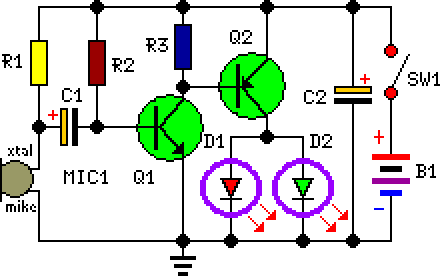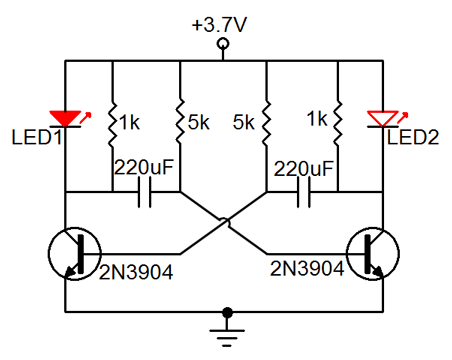
Flashing Eyes

This circuit is designed as a humorous Halloween gadget. It is intended to be placed at the back of a badge or pin featuring a typical Halloween character image, such as a pumpkin, skull, black cat, witch, or ghost. Two LEDs are positioned in place of the character's eyes and will illuminate with varying brightness in response to the rhythm of music or speech picked up by a small microphone. Two transistors are used to provide the necessary amplification and drive the LEDs. Any general-purpose small signal transistor can be utilized for Q1 and Q2; however, it is important to note that R3 may require adjustment based on the gain of Q1. For medium gain transistors, the suggested value should suffice. High gain transistors will necessitate a lower resistance value for R3, typically around 390 to 470 Ohms. Alternatively, R3 can be replaced with a 1K trimmer to allow for precise adjustment of the circuit's threshold.
The circuit operates by detecting sound through a microphone, which converts acoustic signals into electrical signals. The microphone's output is relatively weak, necessitating amplification to drive the LEDs effectively. The first transistor (Q1) serves as the initial amplifier, boosting the microphone's signal. The second transistor (Q2) further amplifies this signal and drives the LEDs, ensuring they respond dynamically to the detected sound.
The brightness of the LEDs, which simulate the character's eyes, varies according to the amplitude of the audio signals. This creates a lively and engaging visual effect, making the gadget suitable for Halloween festivities. The choice of transistors is crucial; small-signal transistors are recommended to ensure adequate performance while maintaining compactness.
R3 plays a critical role in setting the gain for Q1; its value must be adjusted according to the specific characteristics of the transistors used. For transistors with medium gain, the standard resistor value is typically adequate. In contrast, high-gain transistors may require a smaller resistance to avoid saturation, resulting in a more responsive circuit. The option to use a 1K trimmer allows for fine-tuning, enabling the user to achieve optimal performance according to their specific application and component variations.
Overall, this Halloween gadget circuit combines simple amplification with creative design to produce an entertaining and interactive experience, enhancing the festive atmosphere during Halloween celebrations.This circuit was purposely designed as a funny Halloween gadget. It should be placed to the rear of a badge or pin bearing a typical Halloween character image, e. g. a pumpkin, skull, black cat, witch, ghost etc. Two LEDs are fixed in place of the eyes of the character and will shine more or less brightly following the rhythm of the music or speech picked-up from surroundings by a small microphone. Two transistors provide the necessary amplification and drive the LEDs. Any general purpose, small signal transistor can be used for Q1 and Q2, but please note that R3 could require adjustment, depending on the gain of Q1. For medium gain transistors, the suggested value should do the job. High gain transistors will require a lower value for R3, i. e. about 390 - 470 Ohm. You can substitute R3 with a 1K Trimmer in order to set precisely the threshold of the circuit. We aim to transmit more information by carrying articles. Please send us an E-mail to wanghuali@hqew. net within 15 days if we are involved in the problems of article content, copyright or other problems.
We will delete it soon. 🔗 External reference
The circuit operates by detecting sound through a microphone, which converts acoustic signals into electrical signals. The microphone's output is relatively weak, necessitating amplification to drive the LEDs effectively. The first transistor (Q1) serves as the initial amplifier, boosting the microphone's signal. The second transistor (Q2) further amplifies this signal and drives the LEDs, ensuring they respond dynamically to the detected sound.
The brightness of the LEDs, which simulate the character's eyes, varies according to the amplitude of the audio signals. This creates a lively and engaging visual effect, making the gadget suitable for Halloween festivities. The choice of transistors is crucial; small-signal transistors are recommended to ensure adequate performance while maintaining compactness.
R3 plays a critical role in setting the gain for Q1; its value must be adjusted according to the specific characteristics of the transistors used. For transistors with medium gain, the standard resistor value is typically adequate. In contrast, high-gain transistors may require a smaller resistance to avoid saturation, resulting in a more responsive circuit. The option to use a 1K trimmer allows for fine-tuning, enabling the user to achieve optimal performance according to their specific application and component variations.
Overall, this Halloween gadget circuit combines simple amplification with creative design to produce an entertaining and interactive experience, enhancing the festive atmosphere during Halloween celebrations.This circuit was purposely designed as a funny Halloween gadget. It should be placed to the rear of a badge or pin bearing a typical Halloween character image, e. g. a pumpkin, skull, black cat, witch, ghost etc. Two LEDs are fixed in place of the eyes of the character and will shine more or less brightly following the rhythm of the music or speech picked-up from surroundings by a small microphone. Two transistors provide the necessary amplification and drive the LEDs. Any general purpose, small signal transistor can be used for Q1 and Q2, but please note that R3 could require adjustment, depending on the gain of Q1. For medium gain transistors, the suggested value should do the job. High gain transistors will require a lower value for R3, i. e. about 390 - 470 Ohm. You can substitute R3 with a 1K Trimmer in order to set precisely the threshold of the circuit. We aim to transmit more information by carrying articles. Please send us an E-mail to wanghuali@hqew. net within 15 days if we are involved in the problems of article content, copyright or other problems.
We will delete it soon. 🔗 External reference





